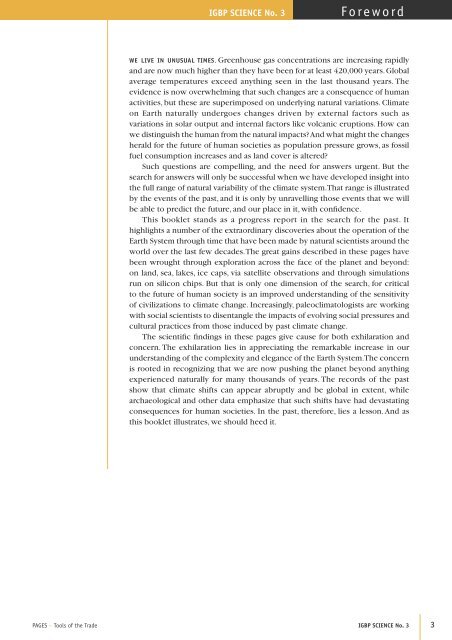Environmental Variability and Climate Change
Environmental Variability and Climate Change
Environmental Variability and Climate Change
You also want an ePaper? Increase the reach of your titles
YUMPU automatically turns print PDFs into web optimized ePapers that Google loves.
IGBP SCIENCE No. 3 Foreword<br />
WE LIVE IN UNUSUAL TIMES. Greenhouse gas concentrations are increasing rapidly<br />
<strong>and</strong> are now much higher than they have been for at least 420,000 years. Global<br />
average temperatures exceed anything seen in the last thous<strong>and</strong> years. The<br />
evidence is now overwhelming that such changes are a consequence of human<br />
activities, but these are superimposed on underlying natural variations. <strong>Climate</strong><br />
on Earth naturally undergoes changes driven by external factors such as<br />
variations in solar output <strong>and</strong> internal factors like volcanic eruptions. How can<br />
we distinguish the human from the natural impacts? And what might the changes<br />
herald for the future of human societies as population pressure grows, as fossil<br />
fuel consumption increases <strong>and</strong> as l<strong>and</strong> cover is altered?<br />
Such questions are compelling, <strong>and</strong> the need for answers urgent. But the<br />
search for answers will only be successful when we have developed insight into<br />
the full range of natural variability of the climate system. That range is illustrated<br />
by the events of the past, <strong>and</strong> it is only by unravelling those events that we will<br />
be able to predict the future, <strong>and</strong> our place in it, with confi dence.<br />
This booklet st<strong>and</strong>s as a progress report in the search for the past. It<br />
highlights a number of the extraordinary discoveries about the operation of the<br />
Earth System through time that have been made by natural scientists around the<br />
world over the last few decades. The great gains described in these pages have<br />
been wrought through exploration across the face of the planet <strong>and</strong> beyond:<br />
on l<strong>and</strong>, sea, lakes, ice caps, via satellite observations <strong>and</strong> through simulations<br />
run on silicon chips. But that is only one dimension of the search, for critical<br />
to the future of human society is an improved underst<strong>and</strong>ing of the sensitivity<br />
of civilizations to climate change. Increasingly, paleoclimatologists are working<br />
with social scientists to disentangle the impacts of evolving social pressures <strong>and</strong><br />
cultural practices from those induced by past climate change.<br />
The scientifi c fi ndings in these pages give cause for both exhilaration <strong>and</strong><br />
concern. The exhilaration lies in appreciating the remarkable increase in our<br />
underst<strong>and</strong>ing of the complexity <strong>and</strong> elegance of the Earth System. The concern<br />
is rooted in recognizing that we are now pushing the planet beyond anything<br />
experienced naturally for many thous<strong>and</strong>s of years. The records of the past<br />
show that climate shifts can appear abruptly <strong>and</strong> be global in extent, while<br />
archaeological <strong>and</strong> other data emphasize that such shifts have had devastating<br />
consequences for human societies. In the past, therefore, lies a lesson. And as<br />
this booklet illustrates, we should heed it.<br />
PAGES – Tools of the Trade IGBP SCIENCE No. 3 3

















